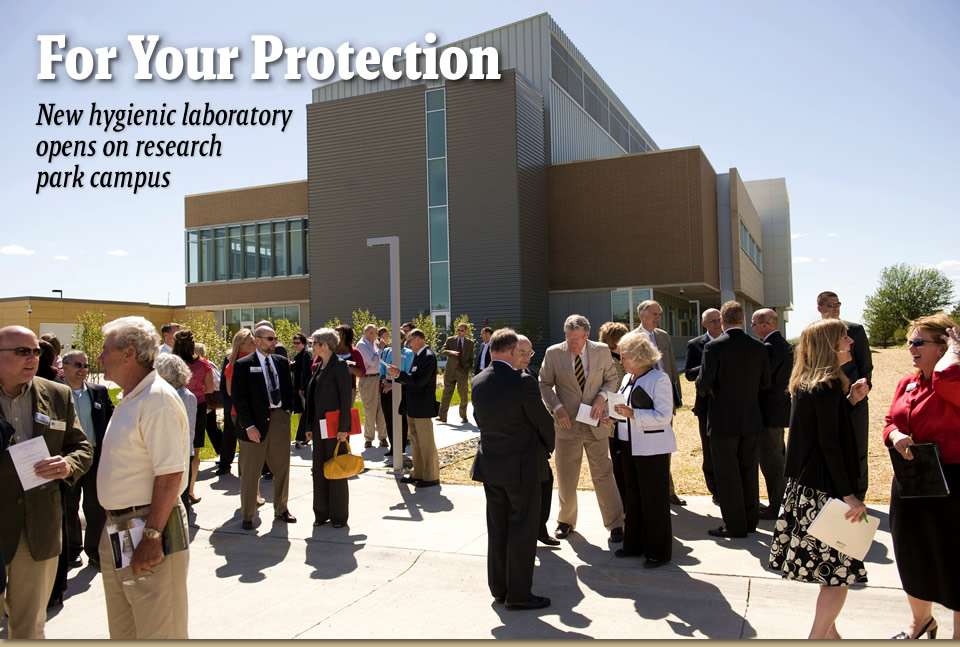-
Page Navigation Links:
- Skip to Site Navigation Links
- Skip to Features

- The University of Iowa
- Spectator
- Monthly News for UI Alumni and Friends
Many Iowans know the State Hygienic Laboratory at The University of Iowa for its work with Novel H1N1 influenza. It was one of the first labs in the nation outside of the Centers for Disease Control and Prevention to conduct testing for this pandemic. What Iowans (and many others) may not realize is the lab’s role in newborn testing, air quality and water quality assessment, and bioterrorism response. Recently, the lab was the first in the nation to confirm Salmonella in deli meat, along with substantiating earlier cases of contaminated peanut butter.
This work took place in Oakdale Hall, a facility built in 1917. But a new lab on the Research Park campus in Coralville, located at Highway 965 and Oakdale Boulevard, offers increased efficiencies for this increasingly important type of testing. The 82,000-square-foot building was dedicated on May 5.
“The new lab will enable us to be much more flexible and to mount a more efficient response to the challenges posed by outbreaks and emerging pathogens,” says Michael Pentella, associate director of the lab. “The space will provide us with opportunities we could not take advantage of in the old facility. It’s also remarkable in that many of the lab staff had the opportunity to provide input into its state-of-the-art design.”
Funded by state and federal appropriations, the $37.75 million facility features an open design, which will facilitate collaboration during disease outbreaks and in environmental emergencies, such as the 2008 flooding. During that natural disaster, staff from multiple sections of the lab came together to rapidly process water testing, insuring a safe supply for municipalities, businesses, and homeowners. While pooling resources in this way is nothing new for the laboratory, the open design will make it much easier.
“We view this new building as a turning point for environmental and public health in the state of Iowa,” says Chris Atchison, director of the State Hygienic Laboratory.
The State Hygienic Lab’s reach is felt across the state and beyond and makes an impression from the first moments of life. As the designated lab for the Iowa Newborn and Maternal Screening Program, the Hygienic Lab provides testing for all babies born in Iowa, North Dakota, and South Dakota. This screening detects metabolic disorders such as PKU that, if left untreated, could cause severe developmental delays, coma, or death.
Immediately after Hurricane Katrina, the Iowa laboratory “adopted” the Louisiana newborn screening program until its facility was relocated and restored two years later. The Hygienic Lab’s newborn screening is conducted in its Ankeny laboratory and the maternal screening in the Coralville facility.
A laboratory may not be the first image that comes to mind when considering emergencies. This lab, however, is designed to quickly respond to multiple threats, including bioterrorism. Its Biosafety Level Three labs test for highly infectious diseases or unknown substances. They are built not only to protect the scientists conducting the work, but also to shield coworkers and others from potential exposure.
Two divisions of the Hygienic Lab that do much of their work outdoors are the Air Quality section and the Limnology group. Air Quality maintains collection sites across the state to measure the particulate matter in the air and to monitor the levels of up to 120 contaminants. The Iowa Department of Natural Resources and the U.S. Environmental Protection Agency use this data to issue alerts when the air quality is poor. Many of the sites continually feed this data in real time to the Hygienic Laboratory web site.
Limnologists—scientists who study surface water and its biological, chemical, and physical makeup—also look for contaminants in some 125 Iowa waterways across the state. They monitor the water and aquatic life for the presence of pesticides, nitrates, and many other abnormalities that reflect man’s impact on the environment.
As the state’s environmental testing center, it is natural that the lab maintained a green philosophy in building its new home. The Coralville facility was constructed using LEED (Leadership in Energy and Environmental Design) principles, the second of this kind for The University of Iowa.
LEED emphasizes environmentally friendly construction practices that result in a healthier place for people to work. More than one-third of the building products used in the Hygienic Lab were manufactured within 500 miles and more than one-third are made from recycled content. Because 90 percent of the building has access to natural light, most of the laboratory work is conducted in a room with a view.
More than 170 employees will make the new Hygienic Laboratory their work home. An additional 63 are employed in the Ankeny location and one is stationed at Lakeside Lab on the shores of Lake Okoboji.
“I envision this new facility as a center for learning where students and professionals can test their theories in our training lab, which we hope to build out with the assistance of a Carver Trust Challenge grant,” says Atchison. “It is truly a unique place that will serve all Iowans in detecting diseases and contaminants that are known and in taking the next step to identify those that have yet to emerge.”
—Pat Blake
with photo by Tim Schoon
© The University of Iowa 2009
